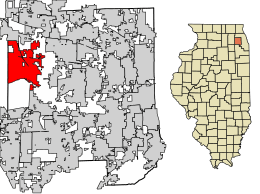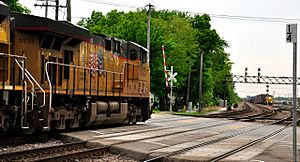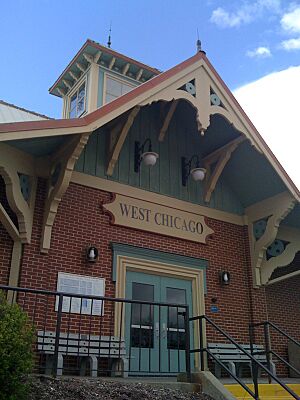West Chicago, Illinois facts for kids
Quick facts for kids
West Chicago, Illinois
|
||
|---|---|---|
 |
||
|
||
| Motto(s):
"Where History and Progress meet..."
|
||

Location of West Chicago in DuPage County, Illinois.
|
||
| Country | ||
| State | Illinois | |
| County | DuPage | |
| Townships | Winfield, Wayne | |
| Incorporated | May 31, 1873 | |
| Government | ||
| • Type | Mayor–council | |
| Area | ||
| • Total | 15.72 sq mi (40.71 km2) | |
| • Land | 15.37 sq mi (39.82 km2) | |
| • Water | 0.34 sq mi (0.89 km2) 2.25% | |
| Population
(2020)
|
||
| • Total | 25,614 | |
| • Density | 1,666.17/sq mi (643.30/km2) | |
| Standard of living | ||
| • Per capita income | $19,287 (median: $63,424) | |
| • Home value | $192,993 (median: $160,200) | |
| ZIP code(s) |
60185, 60186
|
|
| Area code(s) | 630 and 331 | |
| Geocode | 80060 | |
| FIPS code | 17-80060 | |
West Chicago is a city located in DuPage County, Illinois, in the United States. In 2020, about 25,614 people lived there. The city was first called Junction, then Turner Junction. It was named after John Bice Turner. He was the president of the Galena and Chicago Union Railroad (G&CU) in 1855.
West Chicago started around the very first place where railroad lines met in Illinois. Even today, you can still use the Union Pacific / West Metra train service from the West Chicago station.
Contents
History of West Chicago
West Chicago has a rich history, especially because of its connection to railroads.
Early Settlers and Railroads
In the 1830s, a man named Erastus Gary moved to the area. He settled on about 760 acres of land near the DuPage River. His son, Elbert Henry Gary, later became the first CEO of U.S. Steel. This was America's first company worth a billion dollars! The city of Gary, Indiana, is named after him.
In 1849, the Galena and Chicago Union Railroad (G&CU) reached the spot where West Chicago is now. A year later, another railroad, the Aurora Branch Railroad, built tracks southwest. This created America's first railroad junction point west of Chicago. A junction is where two or more railroad lines meet.
Growth of a Railroad Town
Because so many trains passed through this junction, the town grew. Facilities were built to provide water and fuel for the trains. A roundhouse was also built. This was a circular building where trains could be stored and repaired. An eating-house and hotel were also built for travelers.
Many new railroad workers and their families moved to the community. The first settlers were mostly from England and Ireland. Germans arrived in the 1860s, and Mexican immigrants came by the 1910s. John B. Turner, the railroad president, owned a lot of land in the center of town. He saw a chance to make money. In 1855, he divided his land into lots and sold them. He named the new community the Town of Junction.
Becoming Turner and West Chicago
The community kept growing. In 1857, Dr. Joseph McConnell and his wife Mary created another part of town. They named it the Town of Turner to honor the railroad president. These two "towns" became known together as Turner Junction.
By 1873, the community was strong and permanent. So, the residents officially became the Village of Turner. In 1888, a new railroad, the Elgin, Joliet & Eastern, built a freight line through town. This railroad offered free land to any factory that wanted to build along its tracks.
To attract more businesses, the community changed its name in 1896 to the Village of West Chicago. Businessmen thought the new name sounded more modern and would help bring in new factories.
Industry and Population Growth
As more industries moved to West Chicago, new jobs became available. The population grew quickly. By 1910, there were 2,378 people living there. Several new businesses opened, including a milk plant, a cabinet company, and a brick company. West Chicago continues to attract businesses and new residents, making it a diverse community today.
In the 1980s and 1990s, the city faced a challenge. There was concern about nuclear waste from an old factory. The Rare Earths Facility had spread waste around the community since the 1930s. A company called Kerr-McGee, which had bought the facility, worked with the city to clean up the waste.
The movie Reach the Rock was filmed in downtown West Chicago in 1998.
Geography of West Chicago
West Chicago is located at coordinates 41°53′18″N 88°12′35″W / 41.888378°N 88.209659°W.
The city covers about 15.72 square miles (40.71 square kilometers). Most of this area, about 15.38 square miles (39.82 square kilometers), is land. The rest, about 0.34 square miles (0.89 square kilometers), is water.
People of West Chicago
In 2020, West Chicago had 25,614 people living in the city. There were 7,838 households, and 6,035 families. The population density was about 1,629 people per square mile.
Many different groups of people live in West Chicago. About 51.85% of the population identified as Hispanic or Latino.
The average household size was 3.92 people, and the average family size was 3.40 people. About 43.7% of the population was under 18 years old. The median age in the city was 34.0 years.
The median income for a household in West Chicago was $77,098. The median income for a family was $88,509.
| Race / Ethnicity (NH = Non-Hispanic) | Pop 2000 | Pop 2010 | Pop 2020 | % 2000 | % 2010 | % 2020 |
|---|---|---|---|---|---|---|
| White alone (NH) | 11,052 | 10,770 | 8,906 | 47.09% | 39.76% | 34.77% |
| Black or African American alone (NH) | 326 | 580 | 701 | 1.39% | 2.14% | 2.74% |
| Native American or Alaska Native alone (NH) | 26 | 31 | 45 | 0.11% | 0.11% | 0.18% |
| Asian alone (NH) | 448 | 1,584 | 2,028 | 1.91% | 5.85% | 7.92% |
| Pacific Islander alone (NH) | 7 | 11 | 0 | 0.03% | 0.04% | 0.00% |
| Other race alone (NH) | 17 | 14 | 103 | 0.07% | 0.05% | 0.40% |
| Mixed race or Multiracial (NH) | 188 | 259 | 549 | 0.80% | 0.96% | 2.14% |
| Hispanic or Latino (any race) | 11,405 | 13,837 | 13,282 | 48.60% | 51.09% | 51.85% |
| Total | 23,469 | 27,086 | 25,614 | 100.00% | 100.00% | 100.00% |
Economy and Jobs in West Chicago
West Chicago is home to several important companies.
Major Employers in the City
Here are some of the top employers in West Chicago, based on a 2017 report:
| # | Employer | # of Employees |
|---|---|---|
| 1 | Jel Sert | 1,000 |
| 2 | West Chicago Elementary School District 33 | 585 |
| 3 | Aspen Marketing Services | 425 |
| 4 | Ball Horticultural Company | 425 |
| 5 | InNocor Inc. | 330 |
| 6 | Mapei | 285 |
| 7 | Community High School District 94 | 244 |
| 8 | OSI Industries | 230 |
| 9 | Sims Recycling Solutions | 200 |
| 10 | New Wincup Holdings | 167 |
| 11 | In The Swim | 150 |
| 12 | Menards | 150 |
| 13 | St. Andrews Golf & Country Club | 150 |
| 14 | Turtle Splash Water Park | 150 |
| 15 | Wood Glen Pavilion LLC | 140 |
Places to Visit in West Chicago
West Chicago has some interesting places to explore.
- Truitt-Hoff Nature Preserve: This preserve is part of DuPage County’s West Chicago Prairie Forest Preserve. It is one of the largest and best-preserved prairies in the Midwest. A prairie is a large area of flat grassland. This prairie was saved because it was on railroad land that was never farmed.
- Kline Creek Farm: This is a living history farm from the 1890s. You can see what farm life was like over a hundred years ago!
- West Chicago City Museum: The museum is in an old building that used to be the Town Hall. It teaches you about the city's past.
Education in West Chicago
West Chicago has several schools for students of all ages.
High Schools in West Chicago
The city has two high schools:
- West Chicago Community High School (a public school)
- Wheaton Academy (a private school)
Elementary and Middle Schools
There are seven public elementary schools in the city: Currier, Pioneer, Wegner, Turner, Indian Knoll, Gary, and Norton Creek. There are also two middle schools: Benjamin and Leman Middle School (LMS). The sports teams for West Chicago Community High School are called the West Chicago Wildcats.
Sister City
West Chicago has one sister city, which helps build friendships between different countries:
 - Taufkirchen, Bavaria, Germany
- Taufkirchen, Bavaria, Germany
See also
 In Spanish: West Chicago (Illinois) para niños
In Spanish: West Chicago (Illinois) para niños




